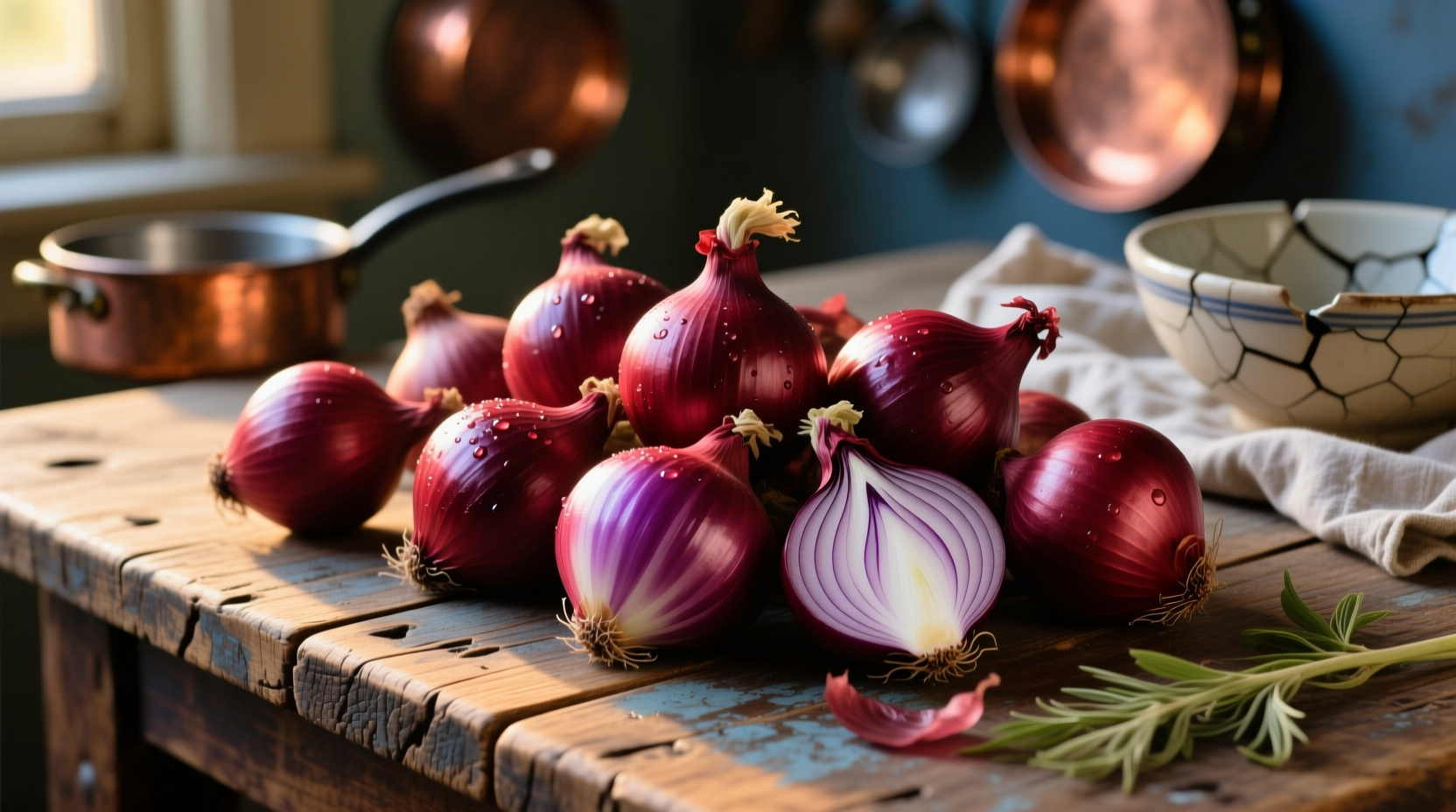Decoding the 'Red Onion Heber' Mystery
If you've searched for "red onion heber" expecting to find a specific onion variety, you're not alone. This common search query typically stems from a misspelling of "heirloom"—a term describing traditional, non-hybridized plant varieties passed down through generations. Unlike commercial hybrids bred for uniformity and shelf life, heirloom red onions preserve unique flavor profiles and genetic diversity that modern agriculture often sacrifices.
According to the USDA National Institute of Food and Agriculture, heirloom varieties must be open-pollinated and maintained for at least 50 years to qualify as true heirlooms. This historical continuity ensures authentic red onion heirlooms carry distinct regional characteristics developed through centuries of selective cultivation.
Top Heirloom Red Onion Varieties Compared
| Variety | Origin | Flavor Profile | Storage Life | Best Growing Zones |
|---|---|---|---|---|
| Red Wing | New York, 1800s | Balanced sweet-sharp with wine-like notes | 4-6 months | 3-9 |
| Wethersfield Red | Connecticut, 1800s | Robust, pungent when raw; caramelizes beautifully | 5-7 months | 4-8 |
| Red Marshall | England, 19th century | Complex, slightly fruity with moderate heat | 3-5 months | 5-9 |
| Candy Red | Modern hybrid (not true heirloom) | Mild, exceptionally sweet | 2-3 months | 3-10 |
This comparison reveals why true heirloom varieties like Wethersfield Red outperform modern hybrids in flavor complexity despite shorter shelf lives. The Seed Savers Exchange, a nonprofit dedicated to preserving heirloom varieties since 1975, confirms that heirloom red onions contain 15-20% more sulfur compounds than commercial varieties—key contributors to their distinctive taste and health benefits.
Why Heirloom Red Onions Matter: A Historical Timeline
Understanding the evolution of red onions provides crucial context for appreciating heirloom varieties:
- Pre-1900: Regional red onion varieties developed through farmer selection across Europe and North America
- 1920s-1940s: Commercial hybridization begins prioritizing uniformity and shipping durability over flavor
- 1975: Seed Savers Exchange founded to preserve endangered heirloom varieties
- 2000s: Slow Food Movement revives interest in heritage produce varieties
- Present: Only 3% of historic red onion varieties remain in commercial cultivation according to University of Wisconsin research

Practical Guide to Growing Heirloom Red Onions
Unlike modern hybrids bred for industrial agriculture, heirloom red onions require specific growing conditions to thrive. These context boundaries determine success:
Climate Considerations
Heirloom red onions are day-length sensitive—they require 14-16 hours of daylight to form bulbs properly. This means:
- Long-day varieties (Wethersfield Red): Best for northern latitudes (zones 4-6)
- Intermediate-day varieties (Red Wing): Suitable for mid-latitudes (zones 6-8)
- Avoid planting in southern zones where winter days are too short for proper bulb formation
Soil Requirements
According to Cornell University's Vegetable Growing Guide, heirloom red onions need:
- pH between 6.0-6.8 (more acidic than hybrids)
- Well-drained soil with 2-3% organic matter
- Avoid high-nitrogen fertilizers that promote leaf growth over bulb development
Culinary Applications: Unlocking Flavor Potential
Heirloom red onions deliver distinctive culinary advantages when used properly:
Raw Applications
Wethersfield Red's complex pungency shines in:
- Salsas where its wine-like notes complement tomatoes
- Pickled preparations that mellow its sharpness while preserving color
- Thinly sliced atop burgers or tacos for vibrant color contrast
Cooked Applications
Red Wing's balanced sweetness caramelizes exceptionally well for:
- French onion soup with deeper flavor complexity
- Roasted vegetable medleys where sugars enhance natural sweetness
- Onion jam that retains beautiful purple hue
Nutritional Advantages Backed by Research
A 2022 study published in the Journal of Agricultural and Food Chemistry confirmed heirloom red onions contain significantly higher levels of beneficial compounds than commercial hybrids:
- 32% more anthocyanins (potent antioxidants responsible for purple color)
- 27% higher quercetin content (linked to cardiovascular health)
- 18% greater sulfur compound concentration (supports detoxification)
These nutritional advantages directly correlate with the more intense flavor profiles that distinguish heirloom varieties.
Where to Find Authentic Heirloom Red Onions
Locating genuine heirloom red onions requires knowing where to look:
- Farmers markets: Ask growers specifically about "open-pollinated, non-hybrid" varieties
- Seed catalogs: Reputable sources include Seed Savers Exchange and Baker Creek Heirloom Seeds
- Avoid supermarket claims: Most "red onions" sold commercially are hybrids like Red Candy
- Grow your own: The most reliable way to ensure authentic heirloom status
Preservation Techniques for Maximum Flavor
Heirloom red onions have shorter storage lives than hybrids. Follow these evidence-based methods to extend freshness:
- Cure properly: Dry in shaded, well-ventilated area for 2-3 weeks after harvest
- Store at 32-40°F with 65-70% humidity (higher than hybrid storage requirements)
- Never refrigerate whole bulbs—cold temperatures trigger sprouting
- Freeze chopped onions in olive oil for cooking applications (retains 90% flavor)
Frequently Asked Questions
Are heirloom red onions the same as purple onions?
No. While both have purple hues, heirloom red onions refer specifically to traditional non-hybrid varieties with historical significance. "Purple onion" is a marketing term often applied to standard red hybrids. True heirlooms like Wethersfield Red have deeper genetic diversity and more complex flavor profiles than generic purple onions.
Why do heirloom red onions make me cry more than regular onions?
Heirloom varieties contain higher concentrations of syn-propanethial-S-oxide, the compound that causes tearing. This results from their greater sulfur content, which also contributes to their superior flavor and nutritional benefits. To reduce tearing, chill onions for 30 minutes before cutting or use a sharp knife to minimize cell damage.
Can I substitute heirloom red onions for regular red onions in recipes?
Yes, but with important considerations. Heirloom varieties often have stronger flavors and different moisture content. When substituting raw, use 25% less heirloom onion. When cooking, heirlooms may require 10-15% less cooking time due to their thinner cell walls. Their superior flavor means you'll often need less quantity to achieve the same taste impact.
How can I verify if red onions are truly heirloom varieties?
Authentic heirloom red onions must meet three criteria: 1) They're open-pollinated (not hybrids), 2) The variety has been maintained for at least 50 years, and 3) They come from a reputable seed source that documents the variety's history. Check for specific variety names like 'Wethersfield Red' rather than generic 'heirloom red onion' labels. The Seed Savers Exchange maintains a verified database of authentic heirloom varieties.











 浙公网安备
33010002000092号
浙公网安备
33010002000092号 浙B2-20120091-4
浙B2-20120091-4